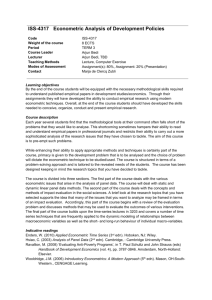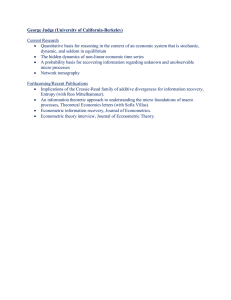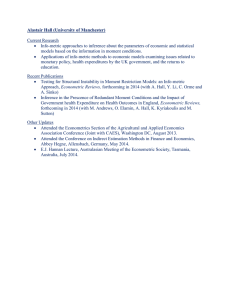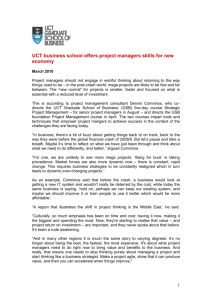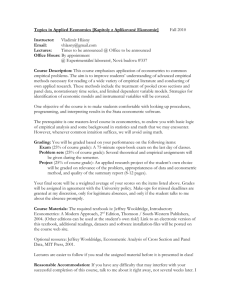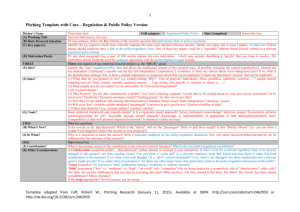The Cross-section of Managerial Ability and Risk Preferences Ralph S.J. Koijen Chicago GSB
advertisement
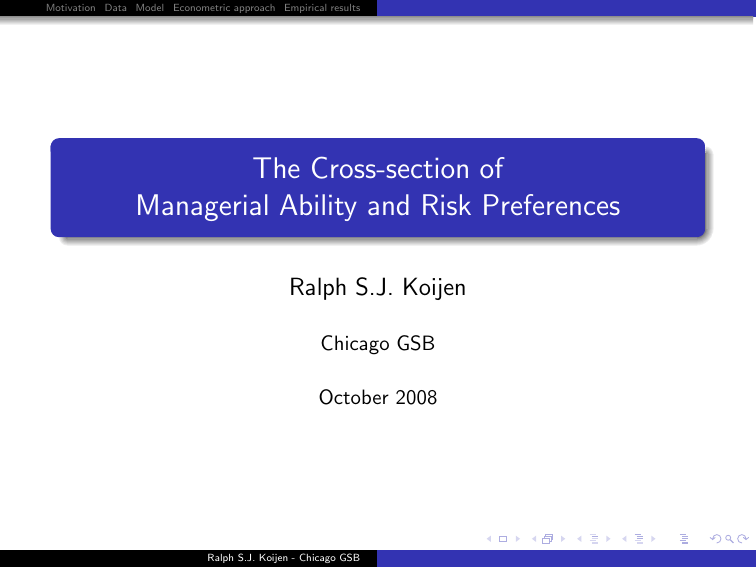
Motivation Data Model Econometric approach Empirical results
The Cross-section of
Managerial Ability and Risk Preferences
Ralph S.J. Koijen
Chicago GSB
October 2008
Ralph S.J. Koijen - Chicago GSB
Motivation Data Model Econometric approach Empirical results
Measuring managerial ability
Mutual fund alphas from a performance regression using style
benchmarks
RitA − rf = αi + βi RtB − rf + εit
Ralph S.J. Koijen - Chicago GSB
Motivation Data Model Econometric approach Empirical results
Measuring managerial ability
Mutual fund alphas from a performance regression using style
benchmarks
RitA − rf = αi + βi RtB − rf + εit
Reduced-form approach ignores that fund returns are the outcome of
a portfolio-choice problem
Brennan (1993), Becker et al. (1999), Cuoco and Kaniel (2007), Basak, Pavlova,
and Shapiro (2007), Binsbergen, Brandt, and Koijen (2007), Yuan (2007),
Wermers, Yao, and Zhao (2007)
Ralph S.J. Koijen - Chicago GSB
Motivation Data Model Econometric approach Empirical results
Measuring managerial ability
Mutual fund alphas from a performance regression using style
benchmarks
RitA − rf = αi + βi RtB − rf + εit
Reduced-form approach ignores that fund returns are the outcome of
a portfolio-choice problem
Brennan (1993), Becker et al. (1999), Cuoco and Kaniel (2007), Basak, Pavlova,
and Shapiro (2007), Binsbergen, Brandt, and Koijen (2007), Yuan (2007),
Wermers, Yao, and Zhao (2007)
Often leads to dynamic strategies that could induce to
misspecifications
Ralph S.J. Koijen - Chicago GSB
Motivation Data Model Econometric approach Empirical results
New approach: Portfolio choice theory
Consider an active portfolio manager’s problem
Manager dynamically selects portfolio to maximize utility
Ralph S.J. Koijen - Chicago GSB
Motivation Data Model Econometric approach Empirical results
New approach: Portfolio choice theory
Consider an active portfolio manager’s problem
Manager dynamically selects portfolio to maximize utility
Two basic components:
1
Managerial ability (λAi ): shapes the investment opportunity set
2
Risk preferences (γi ): determine which portfolio is selected along
this set
Ralph S.J. Koijen - Chicago GSB
Motivation Data Model Econometric approach Empirical results
New approach: Portfolio choice theory
Consider an active portfolio manager’s problem
Manager dynamically selects portfolio to maximize utility
Two basic components:
1
Managerial ability (λAi ): shapes the investment opportunity set
2
Risk preferences (γi ): determine which portfolio is selected along
this set
Main idea: Use restrictions from structural portfolio management
models to estimate the cross-section of managerial ability and risk
preferences
Analogy: Use household’s Euler condition to estimate preference
parameters
Hansen and Singleton (1983), Vissing-Jorgensen and Attanasio (2003), and
Gomes and Michaelides (2005)
Ralph S.J. Koijen - Chicago GSB
Motivation Data Model Econometric approach Empirical results
Main economic questions
Main economic questions:
1
Which economic restrictions follow from portfolio choice theory
2
What can we learn about the dynamics of mutual fund strategies?
3
Does heterogeneity matter?
Ralph S.J. Koijen - Chicago GSB
Motivation Data Model Econometric approach Empirical results
Main economic questions
Main economic questions:
1
Which economic restrictions follow from portfolio choice theory
2
What can we learn about the dynamics of mutual fund strategies?
3
Does heterogeneity matter?
Main answers:
1
Economic restrictions can be used to disentangle both attributes
2
Fund alphas reflect both ability and risk preferences
3
Second moments of fund returns contain information about the
manager’s attributes
4
Structural model captures important dynamics of fund strategies
5
Heterogeneity matters: utility costs up to 4% per annum by ignoring
heterogeneity
Ralph S.J. Koijen - Chicago GSB
Motivation Data Model Econometric approach Empirical results
Main economic questions
Main economic questions:
1
Which economic restrictions follow from portfolio choice theory
2
What can we learn about the dynamics of mutual fund strategies?
3
Does heterogeneity matter?
Main answers:
1
Economic restrictions can be used to disentangle both attributes
2
Fund alphas reflect both ability and risk preferences
3
Second moments of fund returns contain information about the
manager’s attributes
4
Structural model captures important dynamics of fund strategies
5
Heterogeneity matters: utility costs up to 4% per annum by ignoring
heterogeneity
Main methodological contribution:
Develop econometric framework to enable likelihood-based inference
in continuous-time, dynamic optimization models
Ralph S.J. Koijen - Chicago GSB
Motivation Data Model Econometric approach Empirical results
Modeling managerial preferences
Model I: preferences for assets under management
Basak, Pavlova, and Shapiro (2007a, 2007b), Chapman, Evans, and Xu (2007)
Model features managerial incentives:
1
Fund flows that depend on past performance
2
Promotion/demotion risk that depends on past performance
Ralph S.J. Koijen - Chicago GSB
Motivation Data Model Econometric approach Empirical results
Modeling managerial preferences
Model I: preferences for assets under management
Basak, Pavlova, and Shapiro (2007a, 2007b), Chapman, Evans, and Xu (2007)
Model features managerial incentives:
1
Fund flows that depend on past performance
2
Promotion/demotion risk that depends on past performance
Model II: preferences for returns relative to the benchmark
Brennan (1993), Becker et al. (1999), Chen and Pennacchi (2007), Binsbergen,
Brandt, and Koijen (2007)
Advantage: Derive cross-equation restriction analytically
Ralph S.J. Koijen - Chicago GSB
Motivation Data Model Econometric approach Empirical results
Modeling managerial preferences
Model I: preferences for assets under management
Basak, Pavlova, and Shapiro (2007a, 2007b), Chapman, Evans, and Xu (2007)
Model features managerial incentives:
1
Fund flows that depend on past performance
2
Promotion/demotion risk that depends on past performance
Model II: preferences for returns relative to the benchmark
Brennan (1993), Becker et al. (1999), Chen and Pennacchi (2007), Binsbergen,
Brandt, and Koijen (2007)
Advantage: Derive cross-equation restriction analytically
Unfortunately, cross-equation restriction for fund alphas strongly
rejected
Analogy: CRRA preferences cannot match consumption and asset
pricing data → Requires a generalization of preferences
Hansen and Singleton (1983), Vissing-Jorgensen and Attanasio (2003), and
Gomes and Michaelides (2005)
Ralph S.J. Koijen - Chicago GSB
Motivation Data Model Econometric approach Empirical results
Modeling managerial preferences
Model points to a desire for underdiversification: managers
overinvest in the active portfolio
Generalize the manager’s preferences: quest for status as a motive
for underdiversification
The manager has preferences for:
1
Assets under management
2
Fund status: relative position in cross-sectional asset distribution
Ralph S.J. Koijen - Chicago GSB
Motivation Data Model Econometric approach Empirical results
Modeling managerial preferences
Model points to a desire for underdiversification: managers
overinvest in the active portfolio
Generalize the manager’s preferences: quest for status as a motive
for underdiversification
The manager has preferences for:
1
Assets under management
2
Fund status: relative position in cross-sectional asset distribution
Different curvature parameters for:
1
Assets under management: controls passive risk taking
2
Fund status: controls active risk taking
Standard models nested
Ralph S.J. Koijen - Chicago GSB
Motivation Data Model Econometric approach Empirical results
Conventional approach to measure ability
Mutual fund alphas from a performance regression using style
benchmarks
RitA − rf = αi + βi RtB − rf + εit
14
12
10
8
6
4
2
0
−0.2
−0.1
Ralph S.J. Koijen - Chicago GSB
0
αi
0.1
0.2
Motivation Data Model Econometric approach Empirical results
Conventional approach to measure ability
Mutual fund alphas from a performance regression using style
benchmarks
RitA − rf = αi + βi RtB − rf + εit
14
12
10
8
6
4
2
0
−0.2
−0.1
0
αi
0.1
0.2
Cross-sectional distribution displays heterogeneity and estimation
error
Ralph S.J. Koijen - Chicago GSB
Motivation Data Model Econometric approach Empirical results
Economic restrictions and efficiency
The impact of imposing the economic restrictions
40
Performance regressions
Structural model
35
30
25
20
15
10
5
0
−0.2
−0.1
0
αi
0.1
The variance of alphas is three times smaller
Ralph S.J. Koijen - Chicago GSB
0.2
Motivation Data Model Econometric approach Empirical results
Main empirical results
Managerial ability and risk aversion are highly positively correlated
2.5
A
Managerial ability (λ )
2
1.5
1
0.5
0
0
5
10
15
20
25
30
35
40
Coefficient of relative risk aversion (RRA(a0))
Ralph S.J. Koijen - Chicago GSB
45
50
Motivation Data Model Econometric approach Empirical results
Outline
1
Data
2
Financial market and preferences
3
Cross-equation restrictions
4
Status model
5
Novel econometric approach to estimate dynamic models of
delegated portfolio management by maximum likelihood
6
Main empirical results
7
Economic costs of heterogeneity
Ralph S.J. Koijen - Chicago GSB
Motivation Data Model Econometric approach Empirical results
Data
Manager-level database based on CRSP data from 1992.1 to
2006.12
Assign each manager-fund combination to one of nine styles
reflecting size and value orientation
Ralph S.J. Koijen - Chicago GSB
Motivation Data Model Econometric approach Empirical results
Data
Manager-level database based on CRSP data from 1992.1 to
2006.12
Assign each manager-fund combination to one of nine styles
reflecting size and value orientation
3,694 unique manager-benchmark combinations consisting of 3,163
different managers and 1,932 different funds
Ralph S.J. Koijen - Chicago GSB
Motivation Data Model Econometric approach Empirical results
Data
Manager-level database based on CRSP data from 1992.1 to
2006.12
Assign each manager-fund combination to one of nine styles
reflecting size and value orientation
3,694 unique manager-benchmark combinations consisting of 3,163
different managers and 1,932 different funds
Construct returns before fees and expenses
Ralph S.J. Koijen - Chicago GSB
Motivation Data Model Econometric approach Empirical results
Data
Manager-level database based on CRSP data from 1992.1 to
2006.12
Assign each manager-fund combination to one of nine styles
reflecting size and value orientation
3,694 unique manager-benchmark combinations consisting of 3,163
different managers and 1,932 different funds
Style composition (R. = Russell)
Mutual fund style
Selected benchmark
Large/blend
Large/value
Large/growth
Mid/blend
Mid/value
Mid/growth
Small/blend
Small/value
Small/growth
Total
S&P 500
R. 1000 Value
R. 1000 Growth
R. Mid-cap
R. Mid-cap Value
R. Mid-cap Growth
R. 2000
R. 2000 Value
R. 2000 Growth
Ralph S.J. Koijen - Chicago GSB
Fraction of
observations (%)
20.1
11.7
11.6
10.2
6.3
13.7
7.8
6.2
12.4
100.0
Number of
observations
714
427
448
383
228
526
291
200
477
3,694
Motivation Data Model Econometric approach Empirical results
Financial market
The manager can trade 3 assets:
Ralph S.J. Koijen - Chicago GSB
Motivation Data Model Econometric approach Empirical results
Financial market
The manager can trade 3 assets:
1
Cash account:
Ralph S.J. Koijen - Chicago GSB
dSt0 = St0 rf dt
Motivation Data Model Econometric approach Empirical results
Financial market
The manager can trade 3 assets:
1
2
Cash account:
dSt0 = St0 rf dt
Style benchmark portfolio:
dStB = StB (rf + σB λB ) dt + StB σB dZtB
Ralph S.J. Koijen - Chicago GSB
Motivation Data Model Econometric approach Empirical results
Financial market
The manager can trade 3 assets:
1
2
Cash account:
dSt0 = St0 rf dt
Style benchmark portfolio:
dStB = StB (rf + σB λB ) dt + StB σB dZtB
3
Idiosyncratic technology of the manager (Active portfolio):
where λAi
dSitA = SitA (rf + σAi λAi ) dt + SitA σAi dZitA ,
measures managerial ability, with Z B , ZiA t = 0
Ralph S.J. Koijen - Chicago GSB
Motivation Data Model Econometric approach Empirical results
Standard model of preferences
Preferences for returns relative to the benchmark:
! 1 − γi
A
R
1
iT
max Et
1 − γi RTB
(xit )t ∈[0,T ]
xit = (xitB , xitA )′ : fractions invested in benchmark and active
portfolio
Optimization subject to the dynamic budget constraint
Ralph S.J. Koijen - Chicago GSB
Motivation Data Model Econometric approach Empirical results
Standard model of preferences
Preferences for returns relative to the benchmark:
! 1 − γi
A
R
1
iT
max Et
1 − γi RTB
(xit )t ∈[0,T ]
xit = (xitB , xitA )′ : fractions invested in benchmark and active
portfolio
Optimization subject to the dynamic budget constraint
Optimal strategy:
xi =
1 −1
1
Σi Λ i + 1 −
e1 ,
γi
γi
with Σi = diag(σP , σAi ), Λi = (λP , λAi )′ , and e1 = (1, 0)′
Ralph S.J. Koijen - Chicago GSB
Motivation Data Model Econometric approach Empirical results
Implications of the cross-equation restriction
Asset dynamics:
dAit
− rf dt = xitA σAi λAi + xitB σB λB dt + xitB σB dZtB + xitA σAi dZitA
Ait
Ralph S.J. Koijen - Chicago GSB
Motivation Data Model Econometric approach Empirical results
Implications of the cross-equation restriction
Asset dynamics:
dAit
− rf dt = xitA σAi λAi + xitB σB λB dt + xitB σB dZtB + xitA σAi dZitA
Ait
Substitute the optimal strategy:
λ2
dAit
λB
γ −1
− rf dt = Ai dt +
+ i
Ait
γi
γσ
γi
|{z}
| i B {z
}
αi
Ralph S.J. Koijen - Chicago GSB
βi
dStB
− rf dt
StB
!
+
λAi
dZitA
γi
|{z}
σ εi
Motivation Data Model Econometric approach Empirical results
Implications of the cross-equation restriction
Substitute the optimal strategy:
λ2
λB
γ −1
dAit
− rf dt = Ai dt +
+ i
Ait
γi
γσ
γi
|{z}
| i B {z
}
αi
dStB
− rf dt
StB
βi
λAi and γi follow from:
βi
=
σ εi
=
Ralph S.J. Koijen - Chicago GSB
λB
γ −1
+ i
γi σ B
γi
λAi /γi
!
+
λAi
dZitA
γi
|{z}
σ εi
Motivation Data Model Econometric approach Empirical results
Implications of the cross-equation restriction
Substitute the optimal strategy:
λ2
λB
γ −1
dAit
− rf dt = Ai dt +
+ i
Ait
γi
γσ
γi
|{z}
| i B {z
}
αi
dStB
− rf dt
StB
βi
λAi and γi follow from:
βi
=
σ εi
=
λB
γ −1
+ i
γi σ B
γi
λAi /γi
The cross-equation restriction on the fund’s alpha, αi :
λB /σB − 1
αi = λ2Ai /γi = σ2εi
βi − 1
Ralph S.J. Koijen - Chicago GSB
!
+
λAi
dZitA
γi
|{z}
σ εi
Motivation Data Model Econometric approach Empirical results
Implications of the cross-equation restriction
Substitute the optimal strategy:
λ2
λB
γ −1
dAit
− rf dt = Ai dt +
+ i
Ait
γi
γσ
γi
|{z}
| i B {z
}
αi
dStB
− rf dt
StB
βi
λAi and γi follow from:
βi
=
σ εi
=
λB
γ −1
+ i
γi σ B
γi
λAi /γi
The cross-equation restriction on the fund’s alpha, αi :
λB /σB − 1
αi = λ2Ai /γi = σ2εi
βi − 1
Main conclusion: Fund alphas
1
2
Reflect ability and risk preferences
Can be estimated from information in second moments
Ralph S.J. Koijen - Chicago GSB
!
+
λAi
dZitA
γi
|{z}
σ εi
Motivation Data Model Econometric approach Empirical results
Empirical results: Preferences for returns rel. to benchmark
Model-implied
S&P 500
Mean
St.dev.
Performance regr.
γi
λAi
αi
βi
σεi
αi
βi
σεi
46.08
108.15
1.36
0.34
6.27%
3.51%
1.10
0.05
4.48%
2.02%
0.82%
2.98%
0.96
0.11
4.10%
1.97%
βi
=
σ εi
=
αi
λB
1
+ 1−
γi σB
γi
λAi /γi
= λ2Ai /γi
Ralph S.J. Koijen - Chicago GSB
Motivation Data Model Econometric approach Empirical results
Empirical results: Preferences for returns rel. to benchmark
Model-implied
S&P 500
Mean
St.dev.
Performance regr.
γi
λAi
αi
βi
σεi
αi
βi
σεi
46.08
108.15
1.36
0.34
6.27%
3.51%
1.10
0.05
4.48%
2.02%
0.82%
2.98%
0.96
0.11
4.10%
1.97%
βi
=
σ εi
=
αi
λB
1
+ 1−
γi σB
γi
λAi /γi
= λ2Ai /γi
It requires underdiversification to match the moments of fund
returns
Ralph S.J. Koijen - Chicago GSB
Motivation Data Model Econometric approach Empirical results
Managerial preferences: The status model
Quest for status as a motive for underdiversification
Ralph S.J. Koijen - Chicago GSB
Motivation Data Model Econometric approach Empirical results
Managerial preferences: The status model
Quest for status as a motive for underdiversification
Motivation status concerns
Hard-wired: Larger funds more visible, higher in ratings, . . .
Evolutionary forces
Strategic interaction among fund managers
Large literature in economics argues that status concerns are
important for financial decision making
Ralph S.J. Koijen - Chicago GSB
Motivation Data Model Econometric approach Empirical results
Managerial preferences: The status model
Quest for status as a motive for underdiversification
Motivation status concerns
Hard-wired: Larger funds more visible, higher in ratings, . . .
Evolutionary forces
Strategic interaction among fund managers
Large literature in economics argues that status concerns are
important for financial decision making
Modeling fund status:
Total mass of managers normalized to unity, with measure µ(·)
Status measured by the percentile rank:
A
̺t (a) = µ i it ≤ a ,
Āt
where ĀT is median fund size
Ralph S.J. Koijen - Chicago GSB
Motivation Data Model Econometric approach Empirical results
Managerial preferences: The status model
Manager’s objective:
"
#
1− γ
AiT 1i
AiT 1−γ2i
1−γ1i
max E0 η
+ (1 − η ) S (1 − γ2i ) ĀT
̺T
,
1 − γ1i
ĀT
(xit )t ∈[0,T ]
where:
̺T (·): maps relative fund size to fund status
S (·): sign function
′ (·) ≥ 0
Restrictions: η ∈ [0, 1], γ1i > 1, and ̺T
Ralph S.J. Koijen - Chicago GSB
Motivation Data Model Econometric approach Empirical results
Managerial preferences: The status model
Manager’s objective:
"
#
1− γ
AiT 1i
AiT 1−γ2i
1−γ1i
max E0 η
+ (1 − η ) S (1 − γ2i ) ĀT
̺T
,
1 − γ1i
ĀT
(xit )t ∈[0,T ]
where:
̺T (·): maps relative fund size to fund status
S (·): sign function
′ (·) ≥ 0
Restrictions: η ∈ [0, 1], γ1i > 1, and ̺T
Comments:
γ2i can be negative
CDF captures the opportunities to improve status
Nests standard model of preferences
Ralph S.J. Koijen - Chicago GSB
Motivation Data Model Econometric approach Empirical results
Fund status and risk taking
Coefficient of relative risk aversion
3.5
Coefficient of relative risk aversion
3
2.5
2
1.5
1
0
0.1
0.2
0.3
0.4
0.5
0.6
Rank percentile
0.7
0.8
0.9
1
For most funds, risk aversion and fund size are positively correlated
γ1i controls passive risk taking, γ2i active risk taking
Ralph S.J. Koijen - Chicago GSB
Motivation Data Model Econometric approach Empirical results
Estimation strategy
Define rtB+h = log StB+h − log StB and r T = {rh , . . . , rT }
Ralph S.J. Koijen - Chicago GSB
Motivation Data Model Econometric approach Empirical results
Estimation strategy
Define rtB+h = log StB+h − log StB and r T = {rh , . . . , rT }
Two-step maximum-likelihood estimation procedure:
1
Estimate ΘB = {λB , σB } using L(r BT ; ΘB )
2
BT , A ; Θ , Θ̂ )
Estimate ΘAi = {λAi , γ1i , γ2i } using L(AT
i0
Ai
B
i |r
Ralph S.J. Koijen - Chicago GSB
Motivation Data Model Econometric approach Empirical results
Estimation strategy
Define rtB+h = log StB+h − log StB and r T = {rh , . . . , rT }
Two-step maximum-likelihood estimation procedure:
1
Estimate ΘB = {λB , σB } using L(r BT ; ΘB )
2
BT , A ; Θ , Θ̂ )
Estimate ΘAi = {λAi , γ1i , γ2i } using L(AT
i0
Ai
B
i |r
BT , A ; Θ , Θ̂ )
Main complication: computing L(AT
i0
A
B
i |r
Ralph S.J. Koijen - Chicago GSB
Motivation Data Model Econometric approach Empirical results
Estimation strategy
Define rtB+h = log StB+h − log StB and r T = {rh , . . . , rT }
Two-step maximum-likelihood estimation procedure:
1
Estimate ΘB = {λB , σB } using L(r BT ; ΘB )
2
BT , A ; Θ , Θ̂ )
Estimate ΘAi = {λAi , γ1i , γ2i } using L(AT
i0
Ai
B
i |r
BT , A ; Θ , Θ̂ )
Main complication: computing L(AT
i0
A
B
i |r
Density of At +h given At unknown:
dAt = At r + xt⋆ (At )′ ΣΛ dt + At xt⋆ (At )′ ΣdZt
Ralph S.J. Koijen - Chicago GSB
Motivation Data Model Econometric approach Empirical results
Using the martingale approach in estimation
I develop a new approach based on martingale techniques of Cox
Huang (1989)
Ralph S.J. Koijen - Chicago GSB
Motivation Data Model Econometric approach Empirical results
Using the martingale approach in estimation
I develop a new approach based on martingale techniques of Cox
Huang (1989)
Main steps of the martingale method:
Ralph S.J. Koijen - Chicago GSB
Motivation Data Model Econometric approach Empirical results
Using the martingale approach in estimation
I develop a new approach based on martingale techniques of Cox
Huang (1989)
Main steps of the martingale method:
1
⋆ ) that solves:
Choose optimal year-end asset level (AT
max E0 [u (AT )]
AT ≥0
s.t.
⋆ = (u ′ )
Solution: AT
−1
( ξ ϕT )
Ralph S.J. Koijen - Chicago GSB
E0 [ ϕT AT ] ≤ A0
Motivation Data Model Econometric approach Empirical results
Using the martingale approach in estimation
I develop a new approach based on martingale techniques of Cox
Huang (1989)
Main steps of the martingale method:
1
⋆ ) that solves:
Choose optimal year-end asset level (AT
max E0 [u (AT )]
AT ≥0
s.t.
⋆ = (u ′ )
Solution: AT
2
−1
E0 [ ϕT AT ] ≤ A0
( ξ ϕT )
By no-arbitrage, time-t assets under management (At⋆ ):
−1
ϕ
At⋆ = Et u ′
( ξ ϕ T ) T = f ( ϕ t ),
ϕt
with f (·) invertible under mild conditions
Ralph S.J. Koijen - Chicago GSB
Motivation Data Model Econometric approach Empirical results
Using the martingale approach in estimation
I develop a new approach based on martingale techniques of Cox
Huang (1989)
Main steps of the martingale method:
1
⋆ ) that solves:
Choose optimal year-end asset level (AT
max E0 [u (AT )]
AT ≥0
s.t.
⋆ = (u ′ )
Solution: AT
2
−1
E0 [ ϕT AT ] ≤ A0
( ξ ϕT )
By no-arbitrage, time-t assets under management (At⋆ ):
−1
ϕ
At⋆ = Et u ′
( ξ ϕ T ) T = f ( ϕ t ),
ϕt
with f (·) invertible under mild conditions
Key insight: transition density ( ϕt ) known exactly
Ralph S.J. Koijen - Chicago GSB
Motivation Data Model Econometric approach Empirical results
Novel econometric approach using martingale techniques
Estimation procedure:
1
Map assets under management (AT ) to the state-price density (ϕT )
2
Change-of-variables (Jacobian) formula for random variables
ℓ At |
rtB , ϕt −h ; ΘA , ΘB
= ℓ ϕt |
rtB ,
ϕt −h ; Θ A , Θ B
∂A⋆ −1 t
+ log ∂ϕt
Exact likelihood up to one expectation computed using Gaussian
quadrature
If u (·) is locally convex, apply concavification techniques
Carpenter (2000), Cuoco and Kaniel (2007), Basak, Pavlova, and
Shapiro (2007)
Enables likelihood-based estimation of a large class of dynamic
models
Ralph S.J. Koijen - Chicago GSB
Motivation Data Model Econometric approach Empirical results
Summary statistics ability and risk aversion
Summary statistics across all styles
Mean
St.dev.
Coeff. of variation
γ1
4.05
2.41
0.60
γ2
9.50
24.57
2.59
RRA
5.16
7.69
1.49
λA
0.28
0.38
1.36
If anything, dispersion in risk aversion higher than in ability
Ralph S.J. Koijen - Chicago GSB
Motivation Data Model Econometric approach Empirical results
Reduced-form α estimates are very noisy
Compare implied estimates from structural model to reduced-form
performance regression:
Reduced-form
β̂i
σ̂Reduced-form
ε,i
α̂Reduced-form
i
Structural
= −.00 + 1.00 β̂i
=
=
−.00 + 1.04σ̂Structural
ε,i
−.00 + 0.99α̂Structural
i
+ ui , R 2 = 97.67%
(2)
2
(3)
+ ui , R = 98.69%
+ ui , R = 35.11%
To match the unconditional moments: intercept equals zero and
slope equals one
Low R-squared in (3) reflects estimation error in reduced-form α
estimates
Variance in fund alphas three times smaller
Ralph S.J. Koijen - Chicago GSB
(1)
2
Motivation Data Model Econometric approach Empirical results
Model specification test
Specification test:
H0 : Performance regression with the same distributional
assumptions
!
dStB
dAit
− rf dt = αi dt + βi
− rf dt + σ εi dZtA
Ait
StB
H1 : Status model
Likelihood ratio test for (non-)nested models to test hypotheses
Vuong (1989)
Perform test at manager’s level; reject if rejection rate exceeds 5%
Rejection rate: 10.3%
Status model captures important dynamics of fund strategies
Ralph S.J. Koijen - Chicago GSB
Motivation Data Model Econometric approach Empirical results
Forecasting ability
Cross-sectional stability (rank correlation):
Risk aversion: 65.0%
Ability: 32.9%
Ralph S.J. Koijen - Chicago GSB
Motivation Data Model Econometric approach Empirical results
Forecasting ability
Cross-sectional stability (rank correlation):
Risk aversion: 65.0%
Ability: 32.9%
Time-series predictability: Two ways to estimate ability over a 3-year
period
1
Appraisal ratio using a performance regression
2
Structural estimation using the status model
Estimate appraisal ratio over the consecutive year (works against the
structural model)
s A 2
Compute the RMSE: E λA
−
λ̂
it
i ,t +1
Ralph S.J. Koijen - Chicago GSB
Motivation Data Model Econometric approach Empirical results
Forecasting ability
Cross-sectional stability (rank correlation):
Risk aversion: 65.0%
Ability: 32.9%
Time-series predictability: Two ways to estimate ability over a 3-year
period
1
Appraisal ratio using a performance regression
2
Structural estimation using the status model
Estimate appraisal ratio over the consecutive year (works against the
structural model)
s A 2
Compute the RMSE: E λA
−
λ̂
it
i ,t +1
Using performance regression: RMSE = 0.6628
Using status model: RMSE = 0.3881
Ralph S.J. Koijen - Chicago GSB
Motivation Data Model Econometric approach Empirical results
Are managers really skilled?
Fraction of alphas that recovers their expense ratio:
Reduced-form approach: 46%
Structural: 31%
Fraction of alphas that significantly exceed their expense ratio:
Reduced-form approach: 9%
Structural: 13%
Structural approach leads to a more positive view on managerial
talent
Ralph S.J. Koijen - Chicago GSB
Motivation Data Model Econometric approach Empirical results
Why are ability and risk aversion positively correlated?
Managerial ability and risk aversion are highly positively correlated
2.5
A
Managerial ability (λ )
2
1.5
1
0.5
0
0
5
10
15
20
25
30
35
40
Coefficient of relative risk aversion (RRA(a0))
45
50
This is consistent with selection effects or reflects career concerns
Ralph S.J. Koijen - Chicago GSB
Motivation Data Model Econometric approach Empirical results
Why are ability and risk aversion positively correlated?
Choose between mutual fund industry and savings bank
The bank provides a known and constant income OT at t = T
Value function mutual fund industry
1
1−γ 2
MF
2
J
=
exp (1 − γ)r +
λA + λB
1−γ
2γ
Value function bank
J OO =
1
1− γ
O
1−γ T
The indifference locus reads
q
λ̄A (γ) = (log OT − r )2γ − λ2B
Fund managers will opt into the industry only if λA ≥ λ̄A (γ)
Ralph S.J. Koijen - Chicago GSB
Motivation Data Model Econometric approach Empirical results
Heterogeneity in ability and risk aversion
Dependent variable
Log(TNA)
Tenure
Turnover
Log(Expenses)
Stock holdings
Loads
12B-1 fees
Log(Family TNA)
Fund age
R-squared
Ability (log(λA ))
Risk aversion (log(RRA))
Estimate
T-statistic
Estimate
T-statistic
-8.87%
7.27%
6.36%
5.04%
-6.37%
-3.41%
0.04%
0.10%
3.53%
-2.55
2.19
2.01
1.16
-2.17
-1.00
0.01
0.03
1.10
-9.99%
4.10%
0.11%
-9.07%
-6.47%
1.17%
4.38%
3.30%
2.48%
-2.93
1.26
0.04
-2.13
-2.24
0.35
1.07
1.00
0.79
13.0%
6.6%
Managers of large funds tend to be less skilled, but more aggressive
Skilled managers are more experienced and have higher turnover
Aggressive managers charge higher expense ratios and hold less cash
Substantial unobserved heterogeneity
Ralph S.J. Koijen - Chicago GSB
Motivation Data Model Econometric approach Empirical results
Differences across investment styles
Risk aversion
Ability
0.4
0.35
2.5
Large/value manager
Small/growth manager
Large/value manager
Small/growth manager
2
0.3
1.5
Density
Density
0.25
0.2
1
0.15
0.1
0.5
0.05
0
0
5
10
15
Coefficient of relative risk aversion
20
0
0
0.5
1
Ability (λA)
Large/value managers are on average more conservative than
small/growth managers
Larger fraction of small/growth managers is skilled
Ralph S.J. Koijen - Chicago GSB
1.5
Motivation Data Model Econometric approach Empirical results
Does heterogeneity matter?
Investor allocates capital to cash, benchmark, and actively-managed
funds
Three ways to account for heterogeneity:
1
Use performance regressions to estimate cross-sectional distribution
2
Ignore heterogeneity: use average values
3
Use status model to estimate cross-sectional distribution
0
−50
Utility costs (bp)
−100
−150
−200
−250
−300
−350
−400
1
Ignoring heterogeneity
Using performance regressions
2
3
4
5
6
7
8
9
Coefficient of relative risk aversion of the individual investor
Ralph S.J. Koijen - Chicago GSB
10
Motivation Data Model Econometric approach Empirical results
Variation in risk aversion and expected returns
The status model endogenously generates time variation in risk
aversion
Time series of expected returns from Binsbergen and Koijen (2007)
0.2
6
Average coefficient of relative risk aversion
5.75
Expected return
5.5
0.1
5.25
5
0.05
4.75
0
1992
1994
1996
The correlation is 62%
Ralph S.J. Koijen - Chicago GSB
1998
2000
2002
2004
4.5
2006
Average coefficient of relative risk aversion
0.15
Motivation Data Model Econometric approach Empirical results
Conclusions
Restrictions implied by theory disentangle managerial ability and
preferences
Ralph S.J. Koijen - Chicago GSB
Motivation Data Model Econometric approach Empirical results
Conclusions
Restrictions implied by theory disentangle managerial ability and
preferences
Ability and risk preferences estimated using information in second
moments
Ralph S.J. Koijen - Chicago GSB
Motivation Data Model Econometric approach Empirical results
Conclusions
Restrictions implied by theory disentangle managerial ability and
preferences
Ability and risk preferences estimated using information in second
moments
Standard models lead to implausible estimates of ability or risk
preferences
Ralph S.J. Koijen - Chicago GSB
Motivation Data Model Econometric approach Empirical results
Conclusions
Restrictions implied by theory disentangle managerial ability and
preferences
Ability and risk preferences estimated using information in second
moments
Standard models lead to implausible estimates of ability or risk
preferences
Imputing status concerns in the manager’s preferences
Delivers plausible estimates of ability and risk aversion
Formally favored over other models and reduced-form performance
regressions
Ralph S.J. Koijen - Chicago GSB
Motivation Data Model Econometric approach Empirical results
Conclusions
Restrictions implied by theory disentangle managerial ability and
preferences
Ability and risk preferences estimated using information in second
moments
Standard models lead to implausible estimates of ability or risk
preferences
Imputing status concerns in the manager’s preferences
Delivers plausible estimates of ability and risk aversion
Formally favored over other models and reduced-form performance
regressions
New framework to estimate continuous-time, dynamic optimization
models
Ralph S.J. Koijen - Chicago GSB
Motivation Data Model Econometric approach Empirical results
Conclusions
Restrictions implied by theory disentangle managerial ability and
preferences
Ability and risk preferences estimated using information in second
moments
Standard models lead to implausible estimates of ability or risk
preferences
Imputing status concerns in the manager’s preferences
Delivers plausible estimates of ability and risk aversion
Formally favored over other models and reduced-form performance
regressions
New framework to estimate continuous-time, dynamic optimization
models
Ignoring heterogeneity: large welfare losses for individual investors
Ralph S.J. Koijen - Chicago GSB
